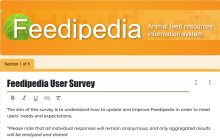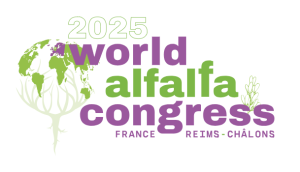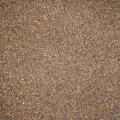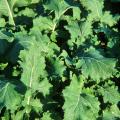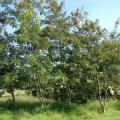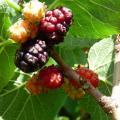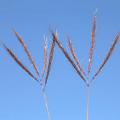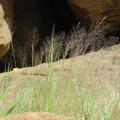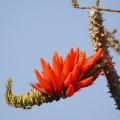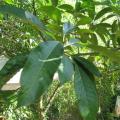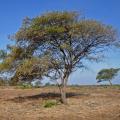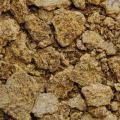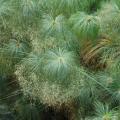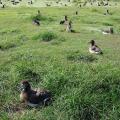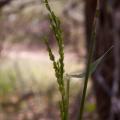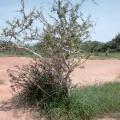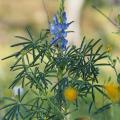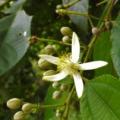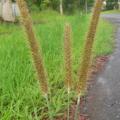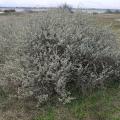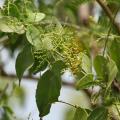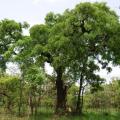Feedipedia news
After 13 years, it is time for the website to be upgraded! Before we start, we need your input.
Explore Feedipedia
|
Rapeseeds - called canola seeds in North America and other countries - are the seeds of... Read more |
Rape forage (Brassica napus L. and interspecific crosses of other Brassica... Read more |
Siamese senna (Senna siamea (Lam.) H.S. Irwin & Barneby) is a medium-sized,... Read more |
|
Black mulberry (Morus nigra L.) is is a small deciduous tree cultivated... Read more |
Marvel grass (Dichanthium annulatum (Forssk.) Stapf) is a tropical grass... Read more |
Sporobolus helvolus (Trin.) Dur. & Schinz. is a perennial grass of the dry... Read more |
|
Coral tree (Erythrina variegata L.) is a spreading tropical and subtropical tree... Read more |
The mango tree (Mangifera indica L.) is primarily cultivated for its edible... Read more |
Indian jujube (Ziziphus mauritiana Lam.) is a shrub or small tree of the dry... Read more |
|
Kapok (Ceiba pentandra (L.) Gaertn.) is a large deciduous tree, best known for... Read more |
Papyrus (Cyperus papyrus L.) is an aquatic sedge mostly known for its use as... Read more |
Goose grass (Eleusine indica (L.) Gaertn.) is an annual or short-lived perennial... Read more |
|
Brachiaria lata (Schumach.) C. E. Hubb. is a fast growing annual grass... Read more |
Boscia (Boscia angustifolia A. Rich.) is an African multipurpose tree that is... Read more |
Blue lupin (Lupinus angustifolius L.) is a legume crop used for seed and fodder... Read more |
|
Bhimal (Grewia optiva J. R. Drumm. ex Burret) is a small multipurpose tree from... Read more |
Golden millet (Setaria sphacelata var. anceps (Schum.) Stapf & Hubb)... Read more |
Beet molasses is the syrupy by-product yielded after the crystallisation of sugar from... Read more |
|
Saltbush (Atriplex halimus L.) is a halophytic perennial shrub that can grow in... Read more |
Saltbush (Salvadora persica Garc.) is an evergreen shrub or small tree that can... Read more |
Afzelia africana Sm. ex Pers. is a tropical African tree, medium to large,... Read more |
Pages
Recent resources
 Opinion paper: Phasing out of the aid provided to the livestock sector during expectedly recurrent emergencies
- Makkar, 2024. animal
Opinion paper: Phasing out of the aid provided to the livestock sector during expectedly recurrent emergencies
- Makkar, 2024. animal
Open access opinion paper that makes a case that the emergency aid do more harm than good to African countries. It is valid for all the fields of agriculture but has direct consequence for animal agriculture. The context here is the aid provided during emergencies that are foreseeable recurrent.
The role of livestock in food security, poverty reduction and wealth creation in West Africa
- Molina-Flores et al., 2020. Food and Agriculture Organization of the United Nations Accra, 2020
Livestock is key to 377 million people in West Africa and in some countries, up to 60% of the population is involved in livestock production. The demand for animal products is increasing with population growth, urbanization, growing middle class, and due to shifting consumer preferences towards animal products. To meet this growing demand, countries in West Africa must engage in accelerated sustainable livestock production undertaking. Livestock development is key to eradicate hunger and poverty. This book attempts to provide up-to-date, and reliable information on the potentials, opportunities, and challenges of the livestock subsector in West Africa.
Pulses and their by-products as animal feed
- Sherasia et al., 2017. In: Calles, T.; Makkar, H. P. S. (Eds), FAO, Food and Agriculture Organization of the United Nations, Rome, Italy
This document provides a state-of-the-art review of the recent research (published and unpublished) on the use of pulses and their by-products as animal feed. It aims at raising awareness on the use of pulses and their by-products. It highlights the nutritional role of pulses and pulse by-products as animal feed and is a contribution to the legacy of the 2016 International Year of Pulses. This document will further enhance the use of these feed resources in other continents, besides Asia, where many pulse by-products are simply dumped. It is also expected that the synthesis presented contributes to make the use of pulses and their by-products as animal feed more efficient. This document will be useful for extension workers, researchers, feed industry, policy-makers and donors alike.









